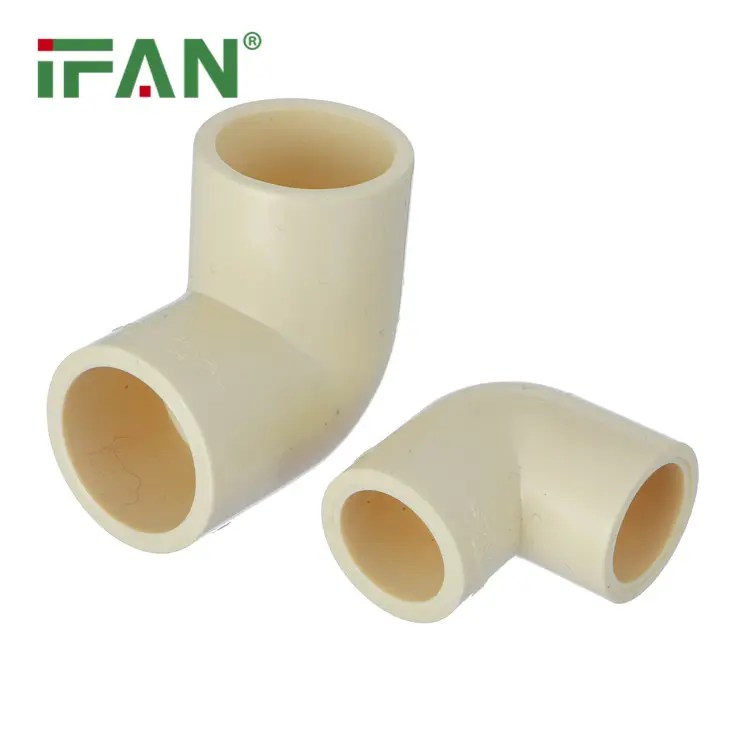CPVC fittings customization requires precision and expertise. ASTM2846 standard ensures reliable performance in demanding applications. This guide covers everything you need to know about customizing CPVC fittings elbows.
Understanding ASTM2846 CPVC Standards
ASTM2846 defines specifications for chlorinated polyvinyl chloride (CPVC) plastic hot and cold water distribution systems. The standard covers pipe dimensions, pressure ratings, and material properties.
CPVC fittings must meet strict temperature and pressure requirements. Maximum continuous operating temperature reaches 200°F (93°C). Working pressure varies based on temperature and pipe size.
Key Benefits of Custom CPVC Fittings Elbows
Custom CPVC elbows solve unique piping challenges. Standard fittings may not fit every application perfectly.
Temperature Resistance: CPVC handles hot water applications where PVC fails. Chemical resistance surpasses metal alternatives in many environments.
Corrosion Protection: Unlike metal fittings, CPVC resists scale buildup and corrosion. This extends system lifespan significantly.
Easy Installation: Solvent welding creates permanent, leak-proof connections. No threading or special tools required.
Common Customization Options
Angle Variations
- 15-degree elbows for tight spaces
- 22.5-degree fittings for gradual direction changes
- 60-degree custom angles for specific layouts
- Compound angles combining multiple directions
Size Modifications
Standard CPVC elbows range from 1/2″ to 12″ diameter. Custom sizes accommodate unique project requirements.
Reducing elbows combine directional change with size transition. This eliminates additional fittings and reduces installation time.
Wall Thickness Adjustments
Schedule 40 and Schedule 80 represent standard wall thicknesses. Custom applications may require intermediate thicknesses for specific pressure ratings.
Thicker walls handle higher pressures but increase material costs. Thinner walls reduce weight and cost for low-pressure applications.
Manufacturing Process for Custom CPVC Elbows
Material Selection
High-quality CPVC compound ensures long-term performance. Virgin resin provides superior strength and chemical resistance compared to recycled materials.
Color additives don’t affect performance but aid in system identification. White, gray, and custom colors available upon request.
Injection Molding Considerations
Mold design affects final product quality. Proper gate placement ensures uniform material flow and minimal stress concentration.
Cooling rate controls crystallization and final properties. Faster cooling improves impact strength but may increase stress.
Quality Control Testing
Each batch undergoes hydrostatic pressure testing. Samples must withstand 2.5 times working pressure for specified duration.
Dimensional verification ensures compatibility with standard CPVC pipe. Automated measurement systems guarantee consistency.
Design Requirements for Custom Applications
Pressure Rating Calculations
System pressure determines wall thickness requirements. Peak pressure, including water hammer effects, sets minimum specifications.
Temperature affects pressure rating significantly. Higher temperatures reduce allowable working pressure substantially.
Flow Optimization
Elbow radius affects pressure drop and flow characteristics. Larger radius reduces turbulence but increases space requirements.
Multiple short-radius elbows create more pressure loss than single long-radius alternatives. Consider system efficiency during design.
Installation Constraints
Available space limits elbow configuration options. Measure clearances carefully before specifying custom angles.
Access for maintenance affects fitting selection. Complex geometries may complicate future repairs or modifications.

Working with Custom CPVC Manufacturers
Specification Documentation
Provide detailed drawings with critical dimensions. Include pressure ratings, temperature requirements, and quantity needed.
Material certifications verify ASTM2846 compliance. Request certificates of analysis for quality assurance.
Lead Time Planning
Custom fittings require longer production schedules than standard items. Plan 4-6 weeks for tooling and initial production.
Minimum order quantities apply to custom products. Discuss volume requirements early in the design process.
Соображения по поводу стоимости
Tooling costs affect small quantity pricing significantly. Consider standard alternatives before committing to custom solutions.
Volume pricing improves economics for larger projects. Standardize custom fittings across multiple applications when possible.
Installation Best Practices
Surface Preparation
Clean pipe ends and fitting sockets thoroughly. Remove dirt, grease, and moisture that could compromise joint strength.
Chamfer pipe ends to prevent scraping primer and cement from socket. Use proper deburring tools for consistent results.
Solvent Welding Procedure
Apply primer to both surfaces according to manufacturer instructions. Allow proper drying time before cement application.
Use appropriate cement for temperature and pressure conditions. Work quickly but carefully during assembly.
Joint Inspection
Proper joints show uniform cement bead around entire circumference. Gaps or voids indicate incomplete fusion.
Allow full cure time before pressure testing. Rush installation compromises long-term reliability.
Quality Assurance and Testing
Dimensional Verification
Check socket depth and pipe engagement during installation. Insufficient insertion weakens joint strength significantly.
Verify angular orientation before cement sets completely. Corrections become impossible after full cure.
Pressure Testing Procedures
Test systems at 1.5 times working pressure minimum. Hold test pressure for specified duration per local codes.
Inspect all joints carefully during testing. Address any leaks immediately using proper repair procedures.
Troubleshooting Common Issues
Joint Failures
Inadequate surface preparation causes most joint problems. Follow cleaning and priming procedures exactly as specified.
Cold weather slows cement cure rates significantly. Allow extended cure times in low-temperature conditions.
Dimensional Problems
Thermal expansion affects system dimensions substantially. Provide adequate expansion joints and supports for long runs.
Improper support spacing causes sagging and stress concentration. Follow manufacturer spacing recommendations strictly.
Future Maintenance Considerations
System Accessibility
Design access points for future maintenance needs. Complex custom fittings may require special procedures for replacement.
Document custom specifications for future reference. Standard replacement parts may not fit properly.
Performance Monitoring
Regular inspection identifies potential problems early. Look for stress cracking, discoloration, or deformation signs.
Water quality affects CPVC longevity significantly. Monitor chemical composition and adjust treatment as needed.
Заключение
Custom ASTM2846 CPVC fittings elbows solve complex piping challenges effectively. Proper specification, manufacturing, and installation ensure reliable long-term performance.
Working with experienced manufacturers streamlines the customization process. Quality materials and proven procedures deliver superior results for demanding applications.
Consider both immediate needs and future requirements during design. Well-planned custom solutions provide excellent value for specialized installations.













Последние комментарии